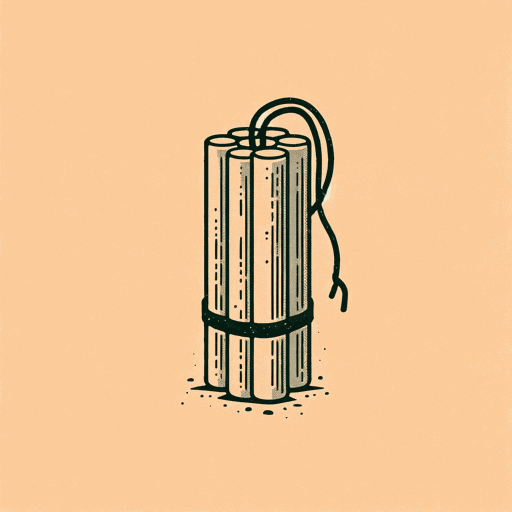78 pages • 2 hours read
Edward AbbeyThe Monkey Wrench Gang
Fiction | Novel | Adult | Published in 1975A modern alternative to SparkNotes and CliffsNotes, SuperSummary offers high-quality Study Guides with detailed chapter summaries and analysis of major themes, characters, and more.
Summary and Study Guide
Overview
Written by environmental advocate Edward Abbey in 1975, The Monkey Wrench Gang tells the story of a motley crew of environmental activists fighting industrialization in the American Southwest. Abbey's most famous work of fiction, this novel inspired a generation of eco-activists. Opening in the so-called "aftermath" (1) of the novel, Abbey immediately situates the reader in media res, at the site of a newly-built bridge between Arizona and Utah, over Glen Canyon. A "workman" (4) in a hardhat makes an adjustment to the bridge's barrier ribbon, which seems to trigger an explosive device that cracks the middle of the bridge. This man is George Hayduke, a member of the novel's titular gang. Hayduke, a "short, broad, burly" (18) former Green Beret kept as a prisoner of war in Vietnam for over a year, forms a group with three others in a fight to protect his beloved native region: the American Southwest. Joining him are: Dr. A.K. Sarvis, aka Doc, a 60-something-year-old cigar-chomping surgeon; Bonnie Abbzug, Doc's assistant and lover, an outspoken, college-educated Jewish woman from the Bronx; and Joseph “Seldom Seen” Smith, a polygamist "jack Mormon" (30) who serves as an outfitter and guide for excursions along the Colorado River.
The four meet on a river-rafting trip guided by Smith. Sitting around the campfire, drinking, and smoking pot, Hayduke complains about "the new power lines" (66), and Smith about "that dam which had plugged up Glen Canyon, the heart of his river, the river of his heart" (66). Doc offhandedly suggests that they should "blow that dam to shitaree" (66). The others agree that they're "only talkin'" (70) but by the next day, they've begun to make plans to take action against their enemies: developers, politicians, and oil, logging, and mining companies. With Doc as their financial backer, the gang assembles outdoor gear, canned and dried foods, and "adequate quantities of Du Pont Straight and Du Pont Red Cross Extra" (71), also known as dynamite. Only Hayduke carries a gun, a .357 Magnum revolver, as Doc says "no violence […] no bloodshed" (73). This remains a point of contention between Hayduke and the gang's other members.
The gang's first operation is to tamper with the bulldozers and other vehicles at the site of a new road's construction. They'll "drain the oil, let the motors run and walk away" (91) so that the engines will seize up, damaging the machines. In a pattern that will hold, Smith and Hayduke work with the bulldozers while Doc and Bonnie stand watch. This arrangement frustrates Bonnie, who complains frequently about boredom and feels discriminated against as the gang's sole female member. The morning after their first raid, another pattern emerges; Hayduke, hotheaded and eager for "creative destruction" (225), sets out for a solo mission: pulling up survey stakes that plot the new road's course.
Over the next few weeks, the gang or portions of the gang commit more acts of sabotage in the name of environmentalism. Their ultimate goal remains the destruction of the Glen Canyon Dam, though the gang knows this may be impossible. Undeterred they galivant through the desert, pushing bulldozers into the canyons, damaging more construction sites and vehicles, and tearing down billboards, provoking the ire of local vigilante Bishop J. Dudley Love and his "Search and Rescue team" (130). The gang also arouses the suspicion of rangers in the National Park Service. Climaxing in a series of actions intended to take out two small bridges, the gang gets trapped in "the Fins, the Land of Standing Rocks" (354). This time, though, the Utah State Police join Bishop Love's small team of men, along with their helicopters, dogs, and heavy artillery.
Starving and severely dehydrated, the gang finds themselves faced with imminent capture. Doc surrenders first, drawn to keep his Hippocratic oath and help Bishop Love, after Love suffers a heart attack. Bonnie, though she's engaged in an intense affair with Hayduke, follows immediately after, loyal to Doc. Smith and Hayduke continue on until Hayduke, who "hates farewells" (388), slips away while Smith sleeps. Smith tries to make it to his third wife's home in Green River but gets caught by park rangers after stealing "two cool packages wrapped in white butcher paper, touched with blood" (393) from the ice chest of some elderly tourists. Hayduke, who has so far improbably survived two run-ins with Bishop Love, succumbs to "a fusillade of gunfire" (407). The novel ends with Smith, Doc, and Bonnie having received light sentences (probation) for their crimes, and all living near each other in Green River. Hayduke miraculously survives the shoot-out with the authorities and reunites with his friends.
In The Monkey Wrench Gang, Abbey shows both the detailed actions of his flawed, conflicted protagonists, and the compelling beauty of the region they fight to preserve. Tackling such huge themes as land use and development, activism, anarchy, and land ownership, Abbey imbues this epic novel with personal ardor for the Southwest. His story and prose inspired, and continues to inspire, environmental activists throughout the United States.


